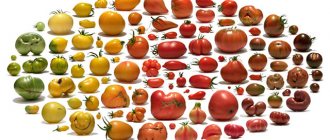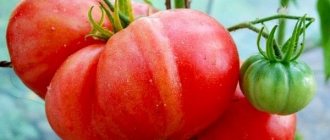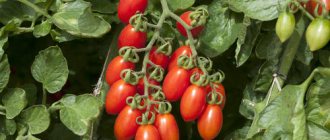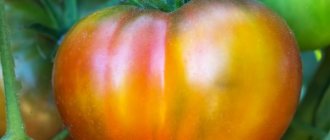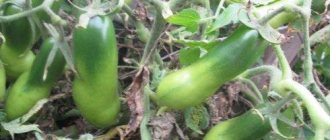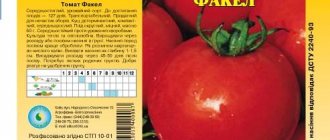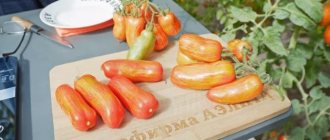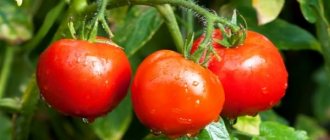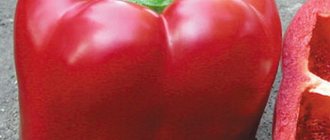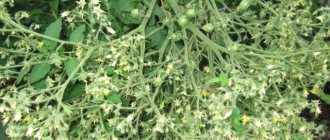Description of the tomato variety
The Krasnobay tomato variety belongs to indeterminate hybrids, the length of the shoots reaches 1.5 m. The hybrid is medium-late in terms of fruit ripening, harvesting occurs after 120 days of cultivation.
Krasnobay tomatoes are grown on supports; the bushes are tall, powerful, and require mandatory pinching. The leaves are dark green, medium in size, the inflorescences are simple. The peculiarity of the Krasnobai variety is that the first inflorescence is formed after the 10th leaf.
Advice! To get a good harvest of fruits of this variety, the plant is formed into one stem.
Description of fruits
The Krasnobai F1 tomato has rounded fruits, which in terms of weight compare favorably with other tall hybrids. The average weight of tomatoes is from 300 to 400 g. However, in order to grow large fruits, you need to pinch the growing point when 8 clusters are formed on the plant.
At the stage of full maturity, the peel of the fruit is bright red, dense, and protects it from cracking. The pulp is sugary and tasty. The dry matter content in fruits reaches 5%. Krasnobay tomatoes are easy to grow, tolerate transportation well, and are suitable for industrial cultivation.
What conditions does culture require?
Krasnobay needs a high level of soil fertility and a temperature during the growing period, not lower than +20 degrees. The variety is recommended to be placed in film greenhouses or polycarbonate greenhouses, providing regular fertilizing.
In the same greenhouse, it is not recommended to place tomatoes next to cucumbers (the plants need different growing conditions), peppers and eggplants (they have common diseases).
With an intensive growing method, the Krasnobaya bush is formed into 1 stem, cutting off all the stepsons and foliage to the first fruits.
For an uninterrupted supply of water and nutrient solutions directly to the bushes, a drip irrigation system is installed.
Characteristics of the variety
In the characteristics and description of the Krasnobay tomato variety, it is stated that the tomatoes do not become smaller during the growing season. Bushes easily adapt to the environment. However, they can only be grown in open ground in the southern regions of Russia. In other areas they do not have time to mature.
The hybrid showed good results when grown in unheated greenhouses. In cloudy summers, when there is insufficient lighting, the bushes bear fruit steadily and the tomato yield does not decrease.
Productivity and fruiting
The domestic tomato Krasnobay is famous for its excellent harvest. If you properly care for the bushes, you can remove up to 15 kg of tomatoes from one plant. From 1 sq. m according to the recommended planting scheme, up to 40 kg of fruits are obtained. In open ground the figures are lower.
The variety bears fruit for a long time. In greenhouse conditions, ripe tomatoes can be picked before frost.
Area of application of fruits
Krasnobay tomatoes make good juice and fruit drink. They are intended mainly for fresh consumption. Some housewives prefer to pickle these tomatoes in barrels. Thanks to their dense pulp, tomatoes can be cut into slices and frozen. The Krasnobay variety is not suitable for whole-fruit canning.
Resistance to diseases and pests
According to reviews, the Krasnobay tomato variety is highly resistant to viral diseases. Bushes rarely suffer from cladosporiosis; they are not afraid of fusarium wilt, tobacco mosaic, and late blight.
In addition, the variety is practically not affected by pests. The roots are not affected by the nematode.
Advantages and disadvantages of the variety
Krasnobay tomatoes have a number of advantages over other domestic and Dutch varieties:
- the hybrid is resistant to diseases and pests;
- the bushes bear fruit abundantly;
- tomatoes tolerate transportation well;
- The fruits have excellent taste and are stored for a long time.
During cultivation, no special shortcomings were noticed. The disadvantages of Krasnobay tomatoes include the need to purchase seeds for planting every time. In addition, to increase yields and large fruits, it is necessary to strictly follow cultivation techniques.
Many gardeners attribute low resistance to weather conditions as a disadvantage of tomatoes. In most regions, the variety is grown only in greenhouses. In addition, according to reviews from those who planted Krasnobay, it was noted that tomatoes do not get along well with other varieties. The photo shows that a separate greenhouse is allocated for these tomatoes.
The history of the hybrid
The Krasnobay tomato was registered in the State Register in 2008. The copyright holder is the Gavrish company, one of the leading companies among Russian seed producers.
The goal of the breeders was to create a plant suitable for cultivation in greenhouses and outdoors, with numerous and large fruits. Not the least attention was paid to the taste characteristics of the tomato. According to reviews from vegetable growers, biologists coped with the task. Krasnobay is a productive and unpretentious hybrid, with large and tasty fruits.
On a note. The difference between the first generation hybrid (f1) and the variety lies in the best characteristics taken from the parent forms. Hybrid plants are superior to their ancestors in yield and other characteristics. But, the effect of hybridization persists only in one generation, without being transmitted further.
Growing rules
Tomatoes of the Krasnobay variety are grown through seedlings. Planting work is planned for early February, since the hybrid does not begin to bear fruit soon.
Planting seedlings
The method of growing Krasnobay tomato seedlings in “snails” showed good results. The seeds germinate quickly, they are easy to care for, and the plantings themselves take up little space. Picking sprouts is not difficult.
For planting you will need:
- small plastic bags;
- priming;
- stationery erasers;
- large plastic container.
It is very important that the soil is loose and moisture-absorbing. Fragile seedlings can easily get sick and die from fungal diseases in heavy, airtight soil. It is not recommended to use ordinary garden soil, as it cakes quickly. But, if there are no other options, then it is enriched with humus, peat, and sand is added as a leavening agent.
Pour soil onto a plastic bag, place the seeds at a distance of 2 cm and roll up the “snail”. Secure the rolls with rubber bands and place them in a plastic container with a small amount of water. When all the water is absorbed into the soil, cover the container with a bag until shoots appear.
When growing Krasnobay tomato seedlings, it is important to observe the temperature regime, since tall tomatoes quickly stretch. For germination they need +22 °C, after which the temperature is lowered to +18 °C. The room must be ventilated, but there should be no draft.
Shoots appear on the 5th day. The bag must be removed so that the sprouts are not blocked. In the future, caring for seedlings comes down to watering and fertilizing. Water carefully so as not to soak the seedlings.
Seedlings are picked in the phase of two true leaves. To do this, simply unwind the roll and remove the plants without damaging the roots. Seedlings are immediately placed in individual 500 ml containers.
Important! Seedlings are fertilized two weeks after picking. Mineral fertilizers are applied in low concentrations.
For Krasnobay seedlings, lighting plays an important role. Tall tomatoes develop quickly, and with a lack of light they become very elongated. To prevent this from happening, additional lighting lamps are used, and tomatoes are sprayed with growth regulators, for example, Athlete. The product stops the growth of the above-ground part, and directs all the strength of the plant to the formation of the root system and stem.
Transfer
The Krasnobay tomato is planted in the garden after 60 days. The photo shows an example of planting seedlings. For 1 sq. m, as a rule, up to three plants are placed. Thickened plantings for the Krasnobay variety are unacceptable.
Before planting in greenhouses, seedlings are accustomed to the ambient temperature. The cassettes are taken out into the fresh air and then left overnight.
Advice! Planting holes are filled with a mixture of organic matter and mineral fertilizers.
Aftercare
Further care and feeding of tomatoes plays a decisive role for large-fruited tomatoes. The soil in the greenhouse should not be acidic, otherwise the nutrients will not be able to be absorbed, and the fruits risk becoming infected with blossom end rot.
According to reviews, during the entire growing season the Krasnobay tomato variety is fed 4 times. Alternate organic and mineral fertilizers. Good results are achieved by foliar foliar feeding, which can protect plants from a number of diseases and strengthen the immune system.
During dry periods, tomatoes are watered generously. The soil should not be allowed to dry out, otherwise the fruits will crack. Soil moisture should be constant.
To increase the yield from one plant, Krasnobay tomatoes are formed into 1 stem. In this case, up to the first flower cluster, all shoots and leaves are completely removed. Next, only the lateral stepsons are broken out, the leaves are thinned out as necessary.
Planting and care
Taking into account the late period of fruit ripening, the hybrid is planted as seedlings 60-70 days before planting in the ground. Like all indeterminate tomatoes, Krasnobay is recommended to be grown in individual containers.
Preparatory activities
For seedlings, buy special soil for tomatoes in the store or collect the substrate yourself. For your own mixture, the ingredients are prepared in advance. You will need:
- crumbly non-acidic peat;
- river sand or vermiculite;
- vermicompost or humus;
- soil taken from under trees in a forest or garden.
Before sowing, it is customary to disinfect the soil and enrich it with fertilizers. To get rid of insects, weed seeds and mold spores, pour boiling water over the substrate or roast in the oven for 30 minutes. Complex mineral fertilizer is applied to the cooled soil according to the instructions.
Hybrid branded seeds do not require dressing or treatment with stimulants. They can be sown dry or pre-germinated in a damp cloth.
Timing and patterns of seed sowing
Sowing of late tomatoes begins in February, when planting seedlings in heated greenhouses - in January. Such early sowing forces the seedlings to be provided with additional lighting. Phytolamps are turned on daily, extending daylight hours to 12-14 hours.
The seeds are sown in separate pots (plastic, peat), to a depth of 1 cm. Until the sprouts appear, the tomatoes are kept at a temperature of +25 degrees.
Planting seedlings in the ground and further care
The Krasnobay hybrid is placed in a greenhouse according to a pattern of 40 by 40 cm, in open ground - every 50-60 cm. Rotted manure 1 kg, wood ash 2 tbsp are added to the planting hole. l. It is necessary to install supports for gartering the stems.
Expert opinion
Stanislav Pavlovich
A gardener with 17 years of experience and our expert See also Characteristics, description and subtleties of growing the Mikado tomato
Ask a Question
Advice. If the seedlings have stretched out, they are buried down to the first true leaves. The stem is placed lying down in the hole; you can roll it into a spiral.
After planting, the bushes are watered, the soil under them is mulched with straw, crushed bark, and grass. Further care consists of watering, fertilizing, and pruning the shoots.
- Water tall tomatoes 2-3 times a week, keeping the soil moderately moist. Warm water should go directly to the roots without getting on the foliage.
- The hybrid is fed 2 times a month, starting from the 10th day after planting the seedlings in the garden. For intensive cultivation, ready-made mineral mixtures for tomatoes are used; with traditional agricultural technology, an infusion of manure, yeast, weeds, and iodine is used. After flowering, phosphorus-potassium fertilizers are used: ash, superphosphate, potassium sulfate.
- In the greenhouse, all excess vegetation is removed from the tomato. In open ground, 1-2 lower shoots are left on the bush, assigning them the role of additional stems. The crown of the plant is removed after the formation of 5-6 clusters.
The tomato does not need artificial pollination, but to increase the ovaries, it is useful to treat flowering greenhouse plants with the preparation Ovary.
Pest and disease control
Reviews of Krasnobay tomatoes and photos of harvests show that with skillful care, the bushes rarely get sick and bear fruit abundantly. As a preventive measure, standard procedures are carried out to increase plant immunity.
In order to prevent late blight, the bushes are sprayed with a solution of serum with iodine. To 10 liters of water add 1 liter of whey and 15 drops of iodine. Spray shoots, fruits, leaves and stems of tomatoes.
Treatments with boric acid help get rid of a complex of diseases, compensate for the lack of boron in plants and stimulate flowering. It is useful to use a soap solution against pests and fumigate the greenhouse with a sulfur bomb before planting. The Colorado potato beetle often bothers tomatoes. Folk remedies or chemicals will help get rid of the pest.
How to grow
Sprouts are planted only after the soil has warmed up . Seeds are sown two months before the planned transplant. February-March are the optimal months for planting seeds.
Seed preparation
Preparing seeds will speed up and increase germination and prevent various infections.
Preparation of planting material:
- They look through all the seeds and select material that can germinate. Blackened and damaged ones are removed, and the seeds are left in their correct, even shape. An easier way is to add salt to the water and soak the planting material in it for 30 minutes. Spoiled seeds will float to the surface and are removed.
- To prevent diseases, seeds are treated with a disinfectant solution. Use hydrogen peroxide or potassium permanganate. The seeds are soaked in the chosen product for two hours, and then thoroughly washed with water.
- For early germination , soak for 12 hours in a growth stimulator. The drug is purchased in stores; aloe juice is used as a home remedy.
THE BEST REMEDY FOR SEED DISINFECTION
Container and soil
Sift the seeds into one large container ; trays and boxes are used for this. When growing several bushes, the seeds are sown immediately in a pot. Peat pots and tablets are suitable for this. When the plant has grown, it is picked and transplanted into a separate container of at least 300 g in size.
Choose light soils . The stores have a large selection of soil for planting tomatoes. Let's prepare the soil at home; for this we take peat, turf and humus in equal proportions. The soil is light and nutritious. Not only the seeds are disinfected, but also the soil and container. The earth is calcined in the oven and watered with a solution of potassium permanganate. Containers are sterilized in the oven or kept in a solution of potassium permanganate.
Sowing
Make small grooves at a distance of 3 cm from each other , the depth of which does not exceed 2 cm. Seeds are poured at intervals of 2 cm. Sprinkle soil on top.
Abundant watering is not required , just moisturizing from a spray bottle is enough. Cover with film or a transparent lid. Place in a warm place. Seeds are planted in other ways. Below is one of the most interesting and unusual methods.
Growing seedlings without soil
We will need a plastic food tray . Line the bottom of the container with soft paper. Cover the top with several layers of paper. The paper is covered with a film in which several holes are made. Moisturize as it dries, using a spray bottle for this.
With this method of planting, plants are planted in a container with soil immediately after the cotyledon leaves appear. If this does not happen, they turn yellow and die due to lack of nutrients.
Growing and care
With proper care of the seedlings, the plants will easily transfer to a permanent location.
How to do it right:
- As soon as two or three true leaves appear, we immediately dive into separate containers.
- Carefully remove plants from the ground without damaging the central root.
- Carefully place the plant in its new location.
Moisten the soil only when it dries . Water with settled water at room temperature without touching the plant itself.
During the period of growing seedlings, fertilize the soil at least three times . Fertilizers must contain a balanced complex of useful substances. Ten days after transplantation, fertilize for the first time for the last time - three days before transplanting into the ground. A second feeding is carried out between them.
Before transplanting into the ground, the plant is hardened off . It is produced if the average air temperature is above +8°C. The seedlings are taken out into the fresh air for 30 minutes, and the time spent outside is gradually increased over the next few minutes.
How to grow tomatoes
Plants are watered and fed abundantly three days before planting , since after transplanting the soil is not moistened for two weeks.
The beds for transplanting seedlings are prepared in the fall . They clear away plant residues and dig up the soil. The soil is fertilized with ash and humus. In the spring, the soil is dug up again. Disinfect the soil by pouring a solution of potassium permanganate or copper sulfate.
Dig holes, maintaining a distance of 50-60 cm between them . The distance between the rows is 60–70 cm. The seats are placed in a checkerboard pattern, this saves space. Before planting, the seedlings are carefully removed from the pots along with a lump of earth and placed in the holes, forming roots towards the center. The holes with plants are filled with water at room temperature. When the water is absorbed, cover it with soil.
Plant care
There are no difficulties in caring for the Krasnobai f1 tomato . You just need to water regularly, loosen the soil and periodically fertilize the soil. Foliar fertilizing of the soil is important.
Important: The hybrid is intended for cultivation in greenhouses - in open ground conditions the fruits will not have time to ripen.
Stepchildren develop poorly, so the plant does not waste nutrients on excess greenery . It is still necessary to remove “empty” shoots in order to form one stem - a standard.
Features of cultivation and possible difficulties
When growing Krasnobay tomatoes, a novice gardener faces a number of difficulties:
- The bush grows too tall and requires staking and pinching.
- If the soil is poor, few ovaries are formed - increase the amount of fertilizing.
- The formation of an excess amount of greenery on a plant indicates oversaturation of the soil, as a result the fruits become smaller and ripen slowly.
- The fruits grow small . By reducing the number of flowers, you will increase the weight of the fruit.
- Crackling and watery fruit means too much foliage has been removed and all the water has passed into the tomatoes.
Reviews from gardeners
Reviews about the Krasnobay hybrid are positive .
The gardeners who grew it were pleased with the harvest and will grow it again. Semyon, Volgograd : “Last year I planted Krasnobay tomatoes for the first time. The hybrid stood out favorably among other varieties. 4-5 clusters formed on the bushes. The fruits are even, weighing from 300 to 500 g. I had to tie up each cluster so that the bush does not break. The taste is average, the tomatoes were used for salads and sauces.”
Elena, Saratov : “Every spring I try to test at least one popular tomato hybrid at home. I recently purchased Krasnobay for this purpose. Because his reviews were wonderful. After the experiment, I agree to continue growing it: this tomato gave me a lot of weighty and tasty fruits, and it has never been affected by diseases or pests.”

